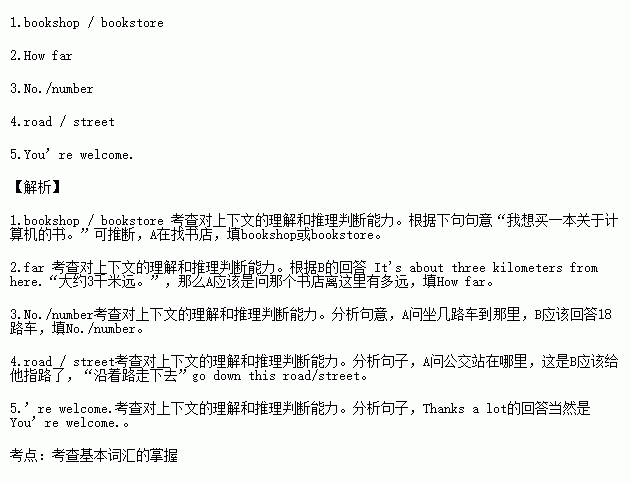题目内容
根据对话内容,在空白处填入恰当的表达。
A:Excuse me. Is there a ____1._______ near here? I want to buy some books on the computer.
B:No. The nearest one is on the Third Street.
A:___2.___ is it from here?
B:It's about three kilometers from here.
A:Can I go there by bus?
B:Yes, you can take a _____3.______ 18 bus.
A:Where's the bus stop?
B:Go down this ___4.____ and turn right at the second crossing. The bus stop is on your left.
A:Thanks a lot.
B:____5._____.
根据对话内容,从对话前的选项中选出能填入空白处的最佳选项,并在答题卡上将该项涂黑。选项中有一项为多余选项。如果选项为E,则涂A和B两项; 如果选项为F,则涂A和C两项。
A.When did it come out? B.How many times have you read it? C.Is it far from here? D.Who is your favorite author? E.It is wonderful. F.So do I. |
A:Hi,Bill! You’re reading the novel again.
B:Yes, Tom. I ’ll never be tired of it.
A: 1.
B: Three times.Every time I read it,I can learn something new.
A: Really? 2.
B: Charles Dickens.I think he is a great English writer.What about you?
A: 3. He is also my favorite foreign writer.Please let me have a look at it.
B:OK, here you are! What do you think of this novel?
A: 4. I haven’t seen a better one for long.Where did you buy it?
B: In the Rose Bookshop.
A:I don’t know where it is. 5.
B: No.Only 10 minutes’ walk from here,next to the People’s Cinema.
A:Oh, I see.I'm going there to get one,too.Thank you!
B:You’re welcome.

